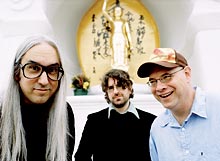Halfway through recording their newest album, Beyond (Fat Possum Records, 2007), Dinosaur Jr. hit a wall. It was the first album with their original lineup in 17 years, and the same animosities between lead singer/guitarist J Mascis and his fellow band members—bassist Lou Barlow and drummer Patrick Murphy (otherwise known as simply “Murph”)—were back. In the past, those differences had alternately fueled the band’s creative spark and driven a wedge between them, and it was threatening to happen all over again.

To say that Mascis’ relationship with Barlow and Murph is unusual is a vast understatement. The rhythm section of Dinosaur Jr. is simultaneously made up of Mascis’ subordinates and collaborators; both are willing to yield to Mascis’ often domineering vision and tastes, but they also bring a unique spark to the band’s sound.
In fact, when Barlow left Dinosaur Jr. after the release of 1988’s Bug, he continued a well-documented feud with Mascis that was carried out through some not-so-thinly veiled songs in Barlow’s band Sebadoh. But the animosities seem to have been tempered with age, and Barlow speaks of his relationship with Mascis without a shred of contentiousness today.
“The dynamic is totally there, but I think that we are mellower,” offers Barlow. “We just accept that it’s there, and we deal with it. Musical chemistry is a strange thing. I’m very comfortable with the relationship I have with J, as ambiguous as that sounds.”
But if the feud between Barlow and Mascis was personal, than the relationship between Mascis and Murph could only be described as creative. Instead of letting the drummer create his own parts for the songs, Mascis instead insisted on dictating to Murph both what he wanted him to play and how he wanted it done. It’s a habit that grew tiresome for Murph, and by the mid-‘90s, he had also left the band.
But in 2005, to celebrate the re-release of the group’s first three albums, Dinosaur Jr. reunited. After finding success on their subsequent reunion tour, band members decided to record a new album and put their past behind them. The band is now in the middle of one of the most unlikely and welcome comebacks in recent rock memory.
“If we’re going to set [our differences] aside, we’re going to set [them] aside,” Barlow says. “I can’t say ‘I’m going to do this’ but still be mad. You have to either put it aside, or not do it.”
Even the once-touchy subject of Mascis dictating Murph’s drum parts has been addressed, although—according to Barlow—not much has changed.
“J knows exactly what he wants Murph to play,” he says. “It just becomes a familiar drawn-out process for us, with J communicating what he needed from Murph. Murph is a real, self-taught drummer. He’s totally got his own thing going on; you have to match that with what J wants, and that’s based on his own idiosyncratic sense of rhythm, and then Murph has to learn it. It’s incredible. It can take a long time, or it can take 10 minutes. J’s sort of averse to making anything that simple.”
But with all their differences put aside, band members still found themselves at a standstill with the recording of Beyond, until fate reared its ugly (if silver-lining-clad) head. While recording the album, the band’s equipment was stolen and never recovered.
“It kind of underscored what was going on. We lost our stuff, and now we have to start over,” explains Barlow. “Now we had new songs and new equipment so I guess that it was for real after that.”
“For real” is the best way to describe Beyond. It’s a gauntlet thrown down to the newest generation of rockers, showcasing Dinosaur Jr. as a band whose power and majesty never really left. Instead, the band does what it does best: Murph’s tight fills provide ample backing for the band, Barlow’s bass offers the perfect structure to the cacophony, and Mascis shows why he may still be rock ‘n’ roll’s most unlikely guitar hero—a mad concoction of Neil Young’s heart and Johnny Thunders’ style.
One thing is for sure: The band hasn’t used its new recording to launch itself as a nostalgia act. Sure, Beyond seems to look back at the band’s past with rose-colored glasses, but it also manages to look forward to a bright future. But the most jarring thing about the album is how it manages to capture the ear-splitting volume of Dinosaur Jr.‘s live shows, which have to be heard (and felt) to really be understood.
“J has this thing, which is to make it loud,” Barlow notes. “That’s where they start from. Make it loud because that’s what people want. I think that J’s formidable experience in music was going to shows and getting his ass kicked by the volume of the music.”
The volume doesn’t just rattle the fans; it also took some getting used to for Barlow himself.
“The thing is, with J and Murph, the way we learn those songs … it’s much more the physical part,” says Barlow. “It’s like a set of muscles. It’s a different thing—it’s really physical.”
But the physicality of Marshall amps aside, Barlow says that this incarnation of Dinosaur Jr. is important because it is the original members salvaging the legacy of a band whose influence and power had long been at risk of being forgotten by the mainstream. “If the Pixies can get back together and make millions of dollars, then we can get back together and play shows,” he says. “Our records are good, and there is still some integrity left with us that kind of lasted, so why not?”
[Jason Bugg is a freelance writer based in Asheville.]
who: Dinosaur Jr. with special guests Awesome Color and The Labiators
what: Neil Young-influenced post-punk
where: Orange Peel
when: Friday, Nov. 30 (9 p.m. $25. www.theorangepeel.net or 225-5851)



bring your ear-plugs … this is the loudest show i’ve ever been to. your ears will bleed!!!!